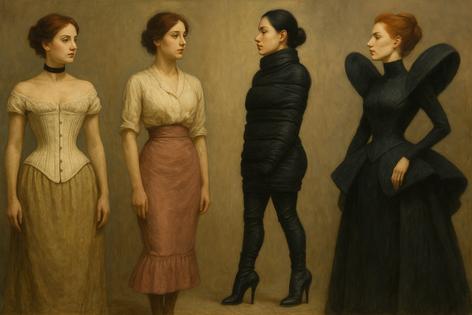Restrictive Fashions You'll Get Into, but Not Out
Published in Fashion Daily News
Clothing is usually celebrated for how it liberates—light fabrics for movement, shoes for speed, coats for protection. Yet fashion history is filled with garments designed not to free but to confine. From corsets that laced until breathing was shallow, to hobble skirts that narrowed steps to a shuffle, restrictive fashions have long shaped the human body and imagination. The paradox is that while these garments seem to limit freedom, they have often been embraced as powerful, alluring, or even empowering.
Corsets and the Cult of Shape
Perhaps the most famous example of restrictive fashion is the corset. Popular across Europe for centuries, the corset shaped the torso into an idealized silhouette: narrow waist, lifted bust, smooth line. But its effect was not only visual. Tight lacing compressed ribs and lungs, forcing posture upright and limiting movement.
Critics decried the health risks, pointing to fainting, organ compression and long-term deformities. Yet for many women, the corset was also a symbol of refinement and beauty. To wear one was to participate in society’s standard of elegance, even if it meant sacrificing comfort. The tension between restriction and empowerment has kept the corset alive in fashion imagination well into modern couture.
The Hobble Skirt Experiment
In the early 20th century, Parisian designer Paul Poiret introduced the hobble skirt. Narrow at the hem, it restricted stride so severely that women could only take tiny steps. While it became briefly fashionable, it was also widely ridiculed. Cartoons of the time showed women stumbling or tripping as they tried to navigate stairs.
Yet the hobble skirt made a cultural point: that restriction itself could be a form of allure. By forcing slower, more deliberate movements, it turned walking into performance. It’s no accident that echoes of the hobble silhouette return periodically in pencil skirts, gowns, and other garments that sculpt movement as well as appearance.
Extreme Footwear
Shoes have long played their part in the restrictive tradition. Ancient Chinese foot binding, now recognized as a brutal practice, was once tied to ideals of beauty and status. In the West, towering chopines in Renaissance Venice and 20th-century stiletto heels both required balance, discipline and tolerance for discomfort.
Platform shoes of the 1970s and sky-high heels of today demonstrate that impractical footwear remains appealing, even when it slows the stride or strains the ankles. The allure is partly visual—the elongation of the leg, the sculptural quality of the shoe—and partly psychological. Restrictive shoes mark fashion as something separate from utility, a kind of art form worn on the body.
Fashion as Constraint
While everyday clothing often prioritizes ease, runway fashion frequently embraces the opposite. Designers like Alexander McQueen, Rei Kawakubo of Comme des Garçons, and Iris van Herpen have created garments that seem almost impossible to inhabit: dresses that cage the torso in metal, gowns that extend skirts into sculptural shapes, or coats that immobilize arms with dramatic silhouettes.
These are not meant for comfort but for provocation. They raise questions about beauty, power and vulnerability. To see a model walking with arms bound in a sculptural sleeve is to be reminded that fashion can transform the body into symbol—sometimes angelic, sometimes monstrous, always striking.
The Psychology of Restriction
Why would people willingly wear clothing that limits their movement? Part of the answer lies in the paradox of fashion itself. Restriction can create posture, elegance, and a sense of ritual. A corset makes the wearer stand straighter; a tight skirt changes the rhythm of a stride; an elaborate gown demands assistance to put on, turning dressing into performance.
There is also the allure of discipline. Restrictive garments require composure, training the body in patience and endurance. For some, the act of wearing them becomes a way to assert control over appearance and identity, even when that control is paradoxically achieved through limitation.
Modern Interpretations
Contemporary fashion often borrows from these restrictive traditions without fully replicating their extremes. Corset-inspired tops, pencil skirts, and architectural shoes echo history while remaining wearable. Streetwear, too, occasionally adopts restriction as style: oversized puffer jackets that limit movement, or pants with exaggerated cuts that challenge mobility.
In performance art and avant-garde circles, restrictive garments are still explored more literally. Costumes that bind, wrap or envelop the body are used to comment on issues of gender, autonomy and surveillance. In these contexts, the garment is both fashion and metaphor.
The Appeal of Getting In, Not Out
What unites straitjackets, armbinders, sleepsacks and their fashion analogues is the fascination with garments designed for entry rather than exit. The act of putting them on is deliberate and often requires assistance. Removing them is not casual. This quality elevates clothing from utility to ritual, drawing attention to the moment of transformation.
For most wearers, such garments are not everyday choices but symbolic statements. They highlight how fashion, at its most provocative, is not about comfort but about creating meaning. To be restricted is to be noticed. To endure limitation is to signal devotion to style.
Enduring Fascination
Even as society embraces comfort—athleisure, sneakers, casual wear—restrictive fashion continues to resurface. Runways return to corsets, celebrities pose in gowns that require help to move, and sculptural shoes capture headlines. The fascination endures because these garments dramatize the relationship between freedom and control, beauty and discomfort, the body and the eye.
Restrictive fashions are paradoxical: garments to get into, but not easily out of. They remind us that clothing is never just about covering the body—it is about shaping how the body is seen, how it moves, and how it feels. In those tensions, fashion finds some of its most enduring power.
========
This article was written, in part, utilizing AI tools.







Comments